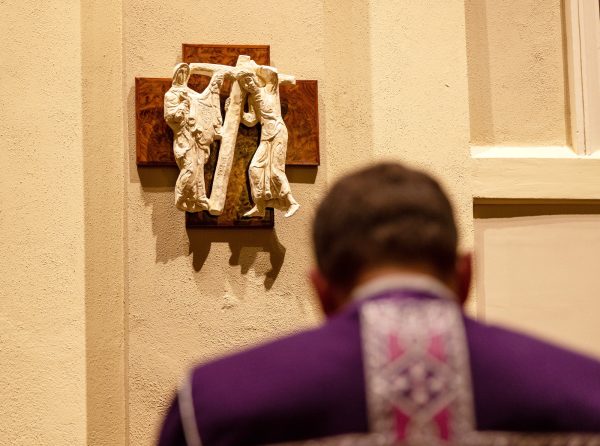The Stations of the Cross have evolved over hundreds of years

Fr. Adam Keiter, rector of the Cathedral of the Immaculate Conception, leads the faithful in the Stations of the Cross on Friday, March 3. (Advance photo)
Indulgence attached to the Stations
A plenary indulgence is granted for those who piously exercise the Stations of the Cross, where they are legitimately erected and while mediating on the passion and death of our Lord (Enchiridion of Indulgences, #63). Those who are impeded from visiting a church may gain the same indulgence by piously reading and meditating on the passion and death of our Lord for one-half hour.
The spiritual pilgrimage known as the Stations of the Cross is a alternative the church developed for those unable to travel to the Holy Land to walk the Via Dolorosa, Jesus’ sorrowful way, in the Old City of Jerusalem.
The stations represent the path Jesus took on his way to his crucifixion, from Pontius Pilate’s court to a site immediately outside of Jerusalem’s walls known as Calvary or Golgotha.
According to Fr. William P. Saunder, the author of Fr. Saunders’ Straight Answers about the Catholic Faith, the stations have evolved since they were first marked around 313 A.D., when Constantine legalized Christianity.
Crowds walks Way of the Cross 300s
“St. Jerome (342-420), living in Bethlehem during the latter part of his life, attested to the crowds of pilgrims from various countries who visited these holy places and followed the Way of the Cross,” he writes.
In the 400s the stations were reproduced so pilgrims wouldn’t have to travel to Jerusalem. “St. Petronius, Bishop of Bologna (who died in 450), constructed a group of chapels at the monastery of San Stefano which depicted the more important shrines of the Holy Land, including several of the stations,” Fr. Saunder writes.
Indulgences attached
After the Franciscans were appointed guardians of shrines in the Holy Land in 1342, indulgences were attached to visiting specific “stations,” a word attributed to William Wey, and Englishman who visited the Holy Land in 1458 and 1462.
Fr. Saunder writes that before Wey described the manner in which a pilgrim followed the steps of Christ, the path was followed in a reverse course, starting from Calvary and ending at Pilates house. It was at this time that today’s path ending at Calvary seems to have taken hold.
In the 1400s and 1500s, during a period of Christian suppression by Moslem Turks, reproductions of the stations were erected at popular spiritual centers. In the 17th century stations were erected in churches. “In 1686, Pope Innocent XI, realizing that few people could travel to the Holy Land due to the Moslem oppression, granted the Franciscans the right to erect stations in all of their churches and that the same indulgences would be given to the faithful for practicing the devotion as if on an actual pilgrimage,” Fr. Sauder writes.
Number of stations fixed at 14
The number and version of stations evolved over the centuries until Pope Clement XII fixed the number at 14 and permitted stations to be erected in all churches.
The stations continue to evolve – unofficially, Fr. Saunder says: “Because of the intrinsic relationship between the passion and death of our Lord with his resurrection, several of the devotional booklets now include a “fifteenth” station which commemorates the Resurrection.”
